#chaoshan
Text

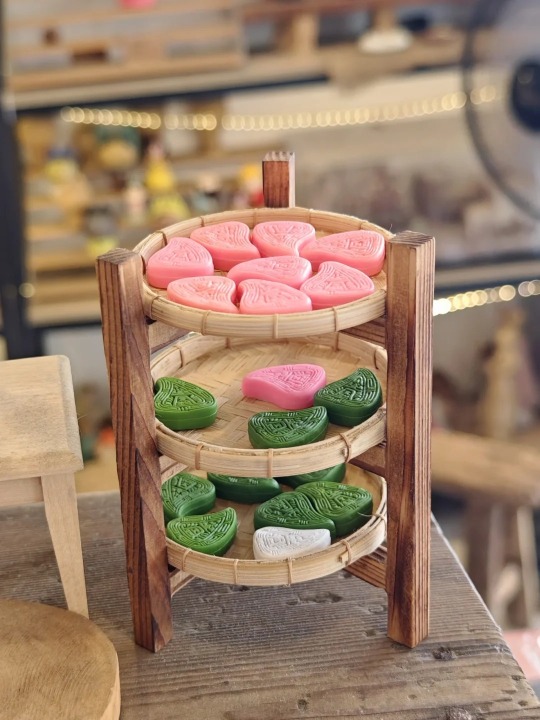
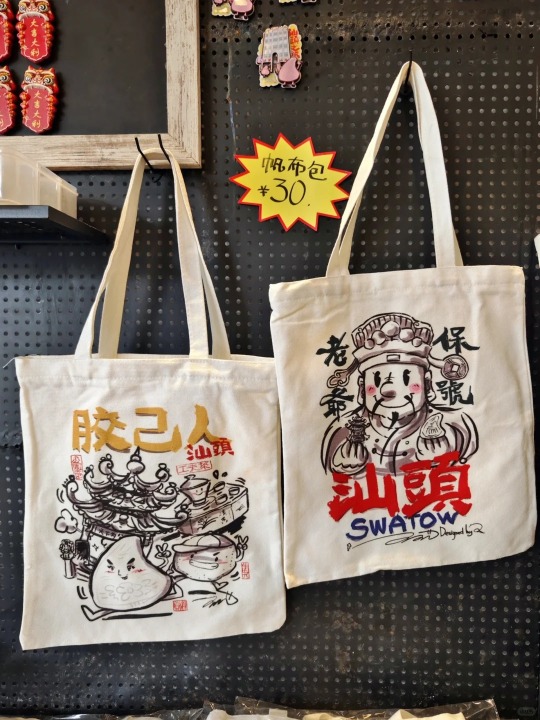
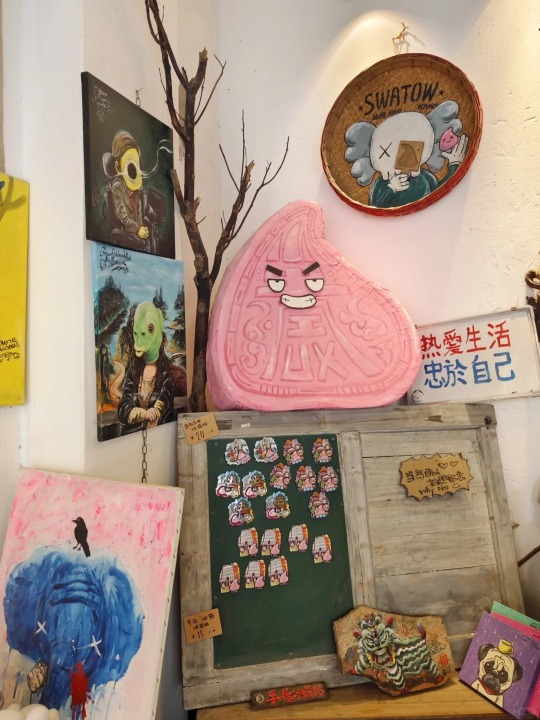

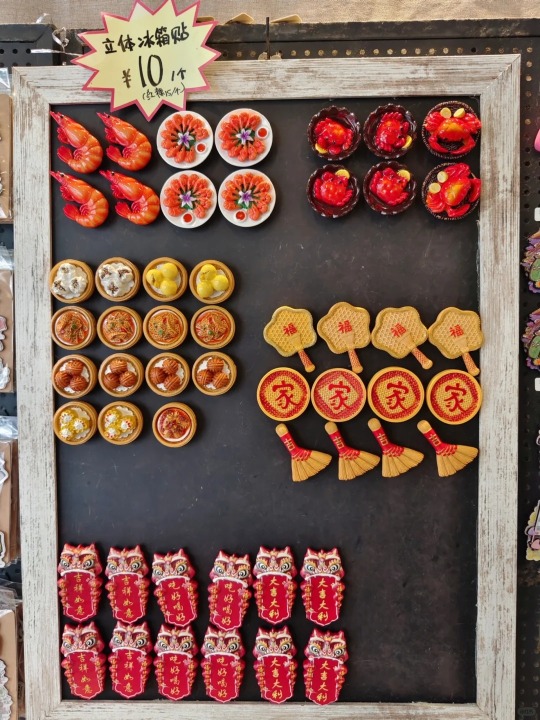
A gift shop called Yòuyì Yuánchuàng (又藝原創) in Shantou, Guangdong province. Shantou is a part of the Chaoshan cultural region and the store sells Chaoshan-inspired souvenirs. The pn̄g-thô-kóe (飯桃粿) or hóng táo guǒ (紅桃粿) which roughly translates to "red peach cake" (though it is more similar to a stuffed dumpling) is an iconic dish of Chaoshan cuisine and features prominently at the store. The pn̄g-thô-kóe has become a symbol of Chaoshan as you can find souvenirs based on the dish all across the region.
Stores like this in China are called wénchuàng diàn (文創店) or 'cultural and creative stores' which typically refers to establishments that specialize in selling unique, artistic, or culturally significant products such as handmade crafts, art pieces, traditional cultural items, creative designs, and so on. They cater to consumers interested in cultural and artistic products and often promote local or traditional culture alongside contemporary creativity.
Images by 市民小林
86 notes
·
View notes
Photo

#潮汕 卤味专门店😋#chaoshan #潮州 #guangdong #中国菜 #chinesefood https://www.instagram.com/p/ChxMy0tBB6-/?igshid=NGJjMDIxMWI=
0 notes
Text
Stitched together some of my favourite Eng Goh Bu clips (潮汕英歌舞)a Teochew folk dance
#潮汕民族文化#英歌舞#英哥#chaoshan culture#teochew culture#抖音#douyin#another video had music over it but i like hearing the percussion and yelling so i made my own post
18 notes
·
View notes
Text
A Spring Festival folk custom local to Chaoshan (Chaozhou and Shantou, Guangdong province) called 盐灶拖神/Yanzao tuoshen ("Yanzao (a village in Yanhong town, Chenghai district, Shantou city) God dragging").
This local custom falls under the greater folk custom of 游神/youshen ("walking the gods"). For youshen customs, and more specifically in Yanzao tuoshen, there is a "god walking team" responsible for carrying the palanquin upon which the god Ying Laoye (营老爷) sits. Ying Laoye is a protector deity local to Chaoshan. The custom of god-walking is not only related to prosperity but also is meant to strengthen the ties of the clans in the villages, and remind the people of their bond; Yanzao is what is known as a "natural village" (自然村落), a village that has been formed naturally after a long period of settlement by villagers whose main occupation is agriculture/farming. The village forms its own customs with family at the center of many of them, as many of the villagers are related. For example, Yanzao has about 20k people divided into four districts; among those numbers, there are about 10k surnamed Lin, 5k surnamed Chen, and 1k surnamed Li and Zhou.
When it comes to Yanzao tuoshen, the god walking team is tasked with safely carrying the god through the village. In the above video, the team is all wearing white. They will often wield incense that they use to hit outsiders with. In other tuoshen processions, the god walking team may be shirtless, their bodies covered in oil to make it difficult for outsiders to grab them and pull them out of the way. The goal of the outsiders is to find a way to get to the palanquin. If the outsiders are able to get onto the palanquin and maintain the position for a length of time, it will bring them good luck. However, surrounding people will usually very quickly pull them down again. If the palanquin is taken over by outsiders, then a "god saving team" will be dispatched to take back the palanquin and continue carrying it through the village.
Usually by the end of the procession, the god is dragged down from the palanquin and is broken apart and sunk into a body of water. On a later auspicious date, the god will then be fished back up, repaired, and returned to the temple for worship. This is meant to bring luck to the villagers.
One folk legend regarding this custom tells that there was once a very poor villager whose turn it was to worship the god, a custom which required him to treat the other villagers to a banquet. However, the poor villager was really too poor, and had no way of supporting others, so he secretly took the god's statue and dragged it to the seaside, burying it there and then running off in the night to Nanyang. Unexpectedly, that year, the village saw bountiful harvest and the poor villager also struck great fortune in Nanyang, leading the villagers to wonder if perhaps the god enjoyed being carried away. This is said to have lead to the tradition of dragging the gods.
Sources (Chinese):
盐灶拖神偶
澄海盐灶拖神习俗的文化解读
自然村落
731 notes
·
View notes
Text
Trying 土虾 "Earth shrimp", a food found in Chaoshan, Guangdong.
[eng by me]
92 notes
·
View notes
Text
Sudden guest post under my music tag.
My friend @erlenwein recently introduced her students to the different styles of Chinese opera. She also showed a video of these styles to me with some commentaries and I asked her to translate them into English (these commentaries very much expanded in the process).
youtube
Fragments of 2024 Lunar New Year Gala from CCTV-1 (main TV channel in Mainland China)
Here are @erlenwein 's commentaries:
1:33
Beijing opera 京剧 presented by two laodan 老旦,the role of older women. The play they're presenting is called ”杨门女将“ ("The female generals of the Yang family"), one of many plots based on the fictionalized story of the military Yang family (Song dynasty period).
https://en.wikipedia.org/wiki/The_Generals_of_the_Yang_Family
2:36
Yuju 豫剧 (Henan opera), Kunqu 昆剧 (around Shanghai, one of the oldest forms of Chinese opera), presented by wenchou 文丑 (comical role, in this case literati). The name of the piece ( “话梨园” ) can be translated as "Talking about the Pear garden" (Pear garden being the metaphorical name for the opera world), but I couldn't find any specifics, and I frankly couldn't be arsed to read the subtitles, sorry.
Fun fact: the white patch on their faces is called 'a piece of tofu'.
3:15
Chuanju 川剧 (Sichuan) presented by a huadan 花旦. The play is ”别洞观景“ ("Looking from a different side of the cave"? Seems like it). The main character singing is 白鳝仙 (Immortal White Eel?) who came to the world of mortals. Check out her use of pheasant feathers!
Usually the most known thing about Sichuan opera is their technique of 变脸, changing the masks really fast, but they decided to showcase a different role here.
https://www.youtube.com/watch?v=5ayy7wcfeHU - Face-changing performance.
3:57
Chaozhou (Teochew) opera 潮剧 (Chaoshan region, southern Fujian and eastern Guangdong), presented by xiaosheng 小生 (young man, usually a romantic character) and huadan 花旦 (young woman in a romance plot). The play is “苏六娘” ("Su Liuniang").
4:34
Pingju 评剧 (Hebei opera), presented by huadan 花旦. The play is “花为媒” (“Matchmaking flowers").
5:07
Yueju 越剧 (Shaoxing opera, from Zhejiang), presented by xiaosheng 小生 and huadan 花旦. Both performers are women — it's typical for Yue opera, since the art form switched to primarily female troupes in 1930s. The play presented is “梁山伯与祝英台” ("Liang Shanbo and Zhu Yingtai"), a very popular story often referred to as "Chinese Romeo and Juliet". You might've seen it also being called "Butterfly Lovers".
6:31
This part is just called 武戏, "military opera". It starts with a wuchou 武丑, comical military role, then wusheng 武生 (military male role) and wudan 武旦 (military female role) come out to present their fighting, juggling, and acrobatic skills. The flags behind their backs show their status as generals/officers.
I can't imagine the skill needed to do this all so seemingly effortlessly.
*I've seen mentions that the flags 靠旗 represent an army under the command of the character wearing them, but I can't find any info on it again to back up my claims. If you know something about it, please let me know!
The piece is titled “杨威奋勇” (I'm not quite sure how to translate it, but it seems to refer to the Yang family again).
8:32
And back to 京剧 with laosheng 老生 (older men, also known as bearded sheng 须生). The play is “龙凤呈祥” ("Dragon and phoenix bringing prosperity").
12 notes
·
View notes
Text
Have you ever come across Yingge Wu? A traditional art form meaning “Dance of Heroes” dating back to the Ming Dynasty (1368-1644), it is a local folk art of Chaoshan in southern China, combining dance, martial arts, and Chinese opera, and includes the rhythmic striking of wooden sticks. Although it is a long-established tradition, Yingge has mostly been a local festivity until recently, when many videos of Yingge performances went viral in China. However, this fascinating folk art is still almost completely unknown in the west.
This dance was originally intended to ward off evil spirits, bring peace and good fortune, and welcome the spring. There are usually 36 performers, each representing one of the 36 heroes of Water Margin (also sometimes translated into English as Outlaws of the Marsh), one of the best known early vernacular Chinese novels, dating back to the 14th century, about a group of outlaws who rebel against the government and are later granted amnesty and enlisted by the same government to defeat invaders. The young performer with the toy snake in the video is demonstrating snake walk, a physically demanding role intended to mimic a snake’s movements.
Most of the performers are around 18 or 19 years old and must train for 6 months to learn the extensive choreography and develop the physical strength and stamina to perform extended dances wearing heavy headwear. The highly intricate makeup is customized for each character, and is usually applied by an experienced Yingge master.
Almost all the locals known some Yingge movements, and children often start training as young as 5. Many inherited this tradition and continue to pass it on to the next generation. There are also all-women’s Yingge troupes, and a hip hop dance group recently performed a Yingge-inspired dance in an international competition.
For those interested, there are numerous mini-documentaries and clips on YouTube showing extended Yingge Wu performances, as well as behind the scenes makeup, choreography, and rehearsals.
Have you ever come across this folk art?
.
.
.
#yingge #yinggewu #chineseart #asianart #chinesehistory #dance #folkart
8 notes
·
View notes
Text
i should make 护国菜 someday. authentic chaoshan dish
4 notes
·
View notes
Text
If mum did not go to the market at Chong Pang, the most likely breakfast for me would be the Vegetarian Rice option. Here I am having the curry mock mutton with potato, creamy sweet imitation pork ribs and pig’s intestines made of flour.
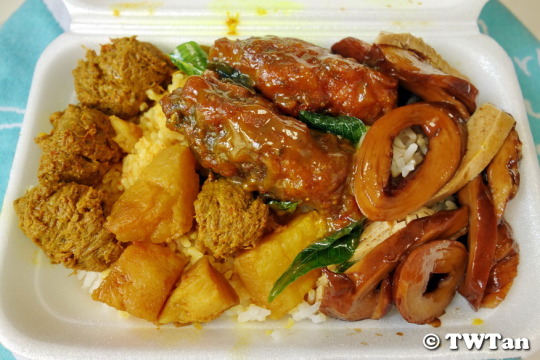
Meanwhile, mum had the dry style Bak Chor Mee or Minced Pork Noodles (肉脞面). If you eat it on premise, the noodles would have comes with a soup but takeaway option don’t. Mum chose mee pok (面薄) or flat and yellow noodles which is of Teochew origin and is commonly served in the Chaoshan region of China and countries with a significant Teochew Chinese immigrant population such as Southeast Asia.

#Breakfast#Takeaway#Packed#Vegetarian Rice#Curry Mutton#Mock#Imitation Food#Potato#Pork Ribs#Pig's Intestine#White Rice#Bak Chor Mee#Minced Pork Noodles#肉脞面#Mee Pok#Flat Yellow Noodles#Braised Mushroom#Pig's Liver#Pork#Food#Buffetlicious
19 notes
·
View notes
Text
The Past, Present, Future of Shenzhen Huang Qiang Bei (Volume 2)
——Slkor, Song Shiqiang
The Past, Present, Future of Shenzhen Huang Qiang Bei (Volume 2)
——Slkor, Song Shiqiang
In 1992, Deng Xiaoping visited Shenzhen, which supported and affirmed the Shenzhen economic model and inspired the people of Shenzhen. With the opening up of China to the outside world, the economic consumption center of Shenzhen gradually moved westward beyond Luohu District, and the focus was in the Futian District in the 1990s. Over the years, a middle class with consumption power emerged, and with the accumulation and development of the industrial base, a market of division of labor and spontaneity was formed. Hua Qiang Bei, located in Futian District, developed into the Hua Qiang Bei Business Circle with the electronics street as the industry leader, creating an economic miracle.
Mr. Song Shiqiang, General Manager of Slkor and Kinghelm
In 1994, Vanguard Super Department moved to Hua Qiang Bei and introduced the Singaporean "warehouse mall" model, which was a key factor in activating the whole Hua Qiang Bei Business Circle. The department store's success led to the transformation of more than 40 buildings in the Shangbu Industrial Zone into commercial areas, and the rise of various other businesses such as the "International Electrical Appliance City" and the "Manha Clothing Mall." The author, Song Shiqiang, also mentions his earliest connection with Hua Qiang Bei and his efforts to work for its prosperity.
Second direct-sale store of SlkorMicro Semicon Co., Ltd. (Slkor) in Hua Qiang Bei, Shenzhen
The market, Hua Qiang Bei, an electronics market in Shenzhen, China has been a hub for small and medium-sized enterprises, and many successful companies have emerged from it.
The author, Song Shiqiang, is the general manager of Kinghelm and Slkor, two companies that started in Hua Qiang Bei. The author discusses the success of the Chinese economy, which he attributes to the complementation of the state-owned enterprises and small private businesses. The author also discusses the growth of Hua Qiang Bei and how it has been nurtured by the government and supported by state-owned enterprises. The passage also contains personal anecdotes about the author's experiences in Hua Qiang Bei and the people he has met there. Finally, the author mentions that Kinghelm and Slkor have moved their headquarters to Shenzhou Computer Building in Bantian, Longgang, and that Slkor's IC design and research team is now located in Korea and Suzhou, while Kinghelm's processing plants are located in Tangxia, Dongguan, and Li.
Hua Qiang Bei is an electronic market located in Shenzhen, China. It is famous for being the world's largest electronics market and a hub for electronic components, including emulational mobile phones, Bluetooth headsets, and other electronic products. The market is known for its fierce competition, creativity, and the ability to produce billionaires. The influx of migrants from Pearl River Delta Region and Shenzhen brings fierce competition and creativity. Hua Qiang Bei Chaoshan bosses are famous for daring to fight, which combines the bloodiness of Hunan people, Society of Brothers tradition of Sichuan and Chongqing people without procrastination. The market's products are mostly electronic components, characterized by storage capacity and convenience of transportation, which can earn money decades later and thousands of kilometers away. Additionally, the market has electronic components with high unit price and high standardization, and the customers are basically 2B manufacturers, making the transaction mostly wholesale, where many people can make money easily. The active electronic components have the characteristics of unique model correspondence; they can't be used universally with a single difference. Therefore, if the products of downstream customers just lack this material, scarce material number can earn a lot of money, which belongs to commercial compensation value. Like Kinghelm and Slkor, Hua Qiang Bei's companies all belong to the electronic and information industries, which is in line with this great era.
Company: Shenzhen SlkorMicro Semicon Co., Ltd.
Contact Person: Mr. Song
Email: [email protected]
Website: http://www.slkoric.com/
Telephone: +86-0755-83044319
City: Shenzhen
2 notes
·
View notes
Photo
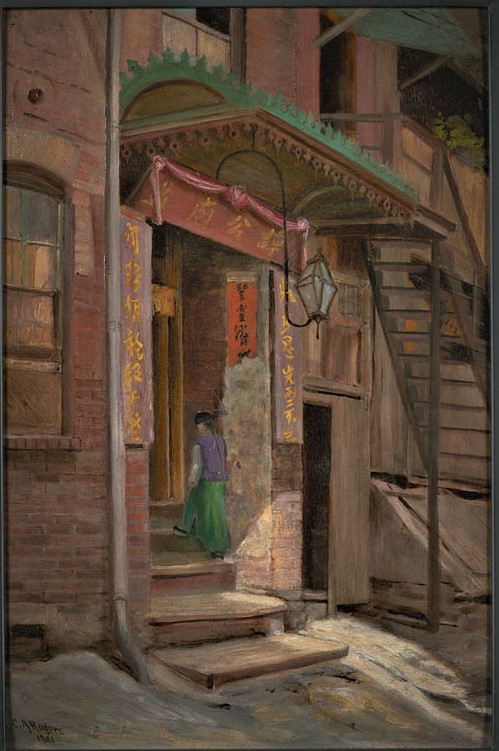
“Entrance to Joss House, Oneida Place” c. 1901 -1902. Painting by Charles Albert Rogers (from the collection of the Bancroft Library).
Lord Tam’s Home on Oneida Place in Old Chinatown
About 15 years ago, The Bancroft Library acquired thirteen paintings of San Francisco's Chinatown by Charles Albert Rogers, dating from 1901-1902. Born in New Haven, Connecticut, in 1848, Rogers studied art in New York and pursued further training in Munich, Paris, and Rome. “By 1877 he was in San Francisco,” according to the Bancroft’s Western Americana Curator Theresa Salazar, “where he painted oil and watercolor portraits, landscapes, and coastal scenes.”
The Bishop directory of 1877 shows a listing for “Rogers Chas., artist, r. cor Washington and Dupont” – residing in the heart of Chinatown. By 1895, the Langley directory shows that he had moved his studio as a “Landscape and portrait painter” to 628 Montgomery Street and residence to 834 Sutter Street. In 1905, the Langley directory shows Rogers living at 509 Van Ness Avenue and a listing among “Artists – Landscape” at the same address. Unfortunately for Rogers, the San Francisco earthquake and fire of April 18, 1906, apparently destroyed his studio and his work which was stored there. After the earthquake, the artist moved to Los Angeles. He would continue to paint, and he died in Alameda, California, in 1918.
In 2008, Salazar wrote for the Bancroft Library’s special edition of reproductions of “The Chinese Experience through Western Eyes” about Rogers’ Chinatown work as follows:
“Rogers' depiction of Chinatown before its destruction in 1906 was fortuitous. Capturing the people and places of this city within a city, he records Chinatown before the earthquake, rendering the typical dress of its inhabitants and the flavor of the humdrum and humble activities of its back alleys. Its ramshackle wooden buildings and tenement houses were far from important architectural structures, as Rogers' paintings attest; but they also attest to the existence of a vibrant community and culture. Each painting bears the artist's original annotation as to location and date, with the time of day also noted on some works. Rogers captures the overlay of Chinese artifacts on the nondescript 19th century brick building — . . . and other objects all create the distinctive characteristics of the neighborhood.”
Unlike many of his contemporaries who painted subjects in old Chinatown, Rogers’ painting of the joss house on Oneida [sic] “alley” remains startlingly faithful to the Chinese signage over the doorway. The first three characters, read right to left in the old style, are 譚公廟 (canto: “Tom Gung miu”) or the “General (or duke or lord) Tam temple.” The painting, thus, confirms Lord Tam, patron saint of seafarers, as the principal icon for this temple and its location on Oneida Place off of Sacramento Street in old San Francisco Chinatown.
According to legend, Tam Gung could forecast the weather. The Lord Tam of historical record was born in Huizhou prefecture where he could cure patients in his childhood. His powers and good acts earned him a place in heaven as an immortal by the age of 20 in the Nine-dragon Mountain in Huizhou and deification during the Qing dynasty. Chinese whose ancestral homes are located in Huizhou or Chaoshan of Guangdong province venerate Tam Gung. In Hong Kong and Macau, Tam Gung or Tam Tai Sin (譚大仙; canto: “Tom daih seen”) is worshiped as a sea deity.
Images of the interior of the Lord Tam and Tam clan association temple are practically nonexistent. If Rogers ever gained admission to sketch the temple’s sanctuary, no such renderings survived.

Oneida Place as shown on the July 1885 map commissioned by the San Francisco Board of Supervisors (from the Cooper Chow collection at the Chinese Historical Society of America).
The best literary description of the Tam temple may be found in Frederic J. Masters’ article “Can a Chinaman Become a Christian?” published in the June – November 1892 issue of The Californian Illustrated Magazine (p. 622). Masters wrote as follows:
“Another temple worth visiting is the small but elegant Joss-house of the Tam Clan. It is one of the oldest in San Francisco, and is found on Oneida place, a dirty, narrow alley branching from Sacramento street. The patriarch Tam is represented with a bald head and a fine, intelligent face. Beautifully gilded and tasseled mottoes hang from the walls and roof. There is one motto that is very appropriate for a temple where kinsmen meet, of which the following is a rude translation: ‘That family with fragrance blooms, whose brethren, like flower calyxes, each to the other bound and all to parent stem, in undivided love abide.’' Another tablet in purple may be rendered in English, thus: ‘Upon us like the rain and dew, thy grace descends forever new.’ Another tablet inscribed by forty-eight names says: ‘The vastness of his mercy is boundless as the sea.’
“The altar service is of very chaste design, the center piece artistically enameled, surmounted with a brass lion with two dragons rampant, each with a projecting red tongue that moves at the least jar or breath of wind. On either side are two huge enameled metal candlesticks in the shape of towers, surmounted by two Caucasian figures dressed in the English costume of a century ago, each wearing stovepipe hats and holding a torch-like candlestick. Worship was being offered by two Chinamen at this temple at the time of our visit.
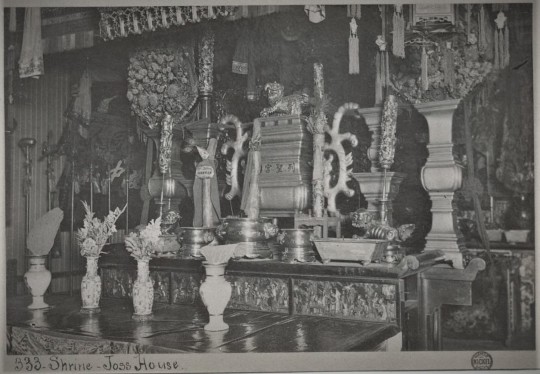
“333. Shrine -- Joss House” no date. Photographer unknown. This as-yet un-identified altar setup (particularly the lion surmounting the central vessel) approximates the altar furnishings described by Frederic Masters survey of San Francisco Chinatown’s various temples in 1892.
“A Chinese temple has no fixed time for religious service; no congregation meets together for united praise and prayer, or sits to listen to some exposition of doctrine and duty. The worshipper comes when he has something to pray about. Family sick-ness, adverse fortune or some risky business undertaking drives him to the oracle. As lie enters the temple he makes his bow to the gods with clasped hands, he lights his candles and incense, kneels upon a mat and calls upon the god by name three times. He then takes up two semi-oval blocks of wood called Yum Yeung Puey, bows toward the idol, prays for good luck and then tosses them up. The success of his supplication depends upon the position in which these blocks fall. If they both fall in the same position the omen is unfavorable; the god has left his office or does not wish to be disturbed. If the blocks fall one with the flat side turned up and the other with the flat surface turned down, the god is supposed to be taking some interest in his business. The worshipper now knocks his head three times three upon the floor, and offers up his petition. This done, he takes a cylindrical bamboo pot containing bam I wo slips about fifteen inches in length, each marked with a number. These are called sticks of fate, and are shaken together with the ends turned to the idol, till one is jostled out. The priest or temple keeper looks at the number, consults his book and hunts up the answer given to the man's prayer. The drum beats and the bell tolls. Offerings of paper money, consisting of beaten tinfoil, a whole armful of which can be bought for half a dollar, are burnt in the furnace and are changed by fire into the currency of the gods. It has taken only ten minutes to burn candles, incense and gilt paper, say his prayers, cast his lot, and get his answer and be on his way home.
“Some happy morning he may be seen repairing to the same, temple to return thanks for some profitable answer to his venture in trade, for a relative restored to health, or for some good fortune believed to have come in prayers. An express wagon drives up to the temple door, containing roast pigs and the choicest vegetables and fruits laid out in trays, which he offers to the god with libations of wine and tea. The god is supposed to feed upon the fumes of the meat and food, after which utilitarian John carts them back home to the family pantry.”
Unlike other better-known temples, such as the Tin How or Lung Kong temples, the Lord Tam temple, and even the small streets comprising Oneida Place, apparently attracted little interest from the photographers of the day. Aside from its temple, Oneida Place’s only other claim to prominence was its listing as an overcrowded residential warren in Samuel Gompers’ notorious pamphlet published in 1902 by the American Federal of Labor “Some Reasons for Chinese Exclusion -- Meat vs. Rice – American Manhood Against Asiatic Coolieism [etc.].”
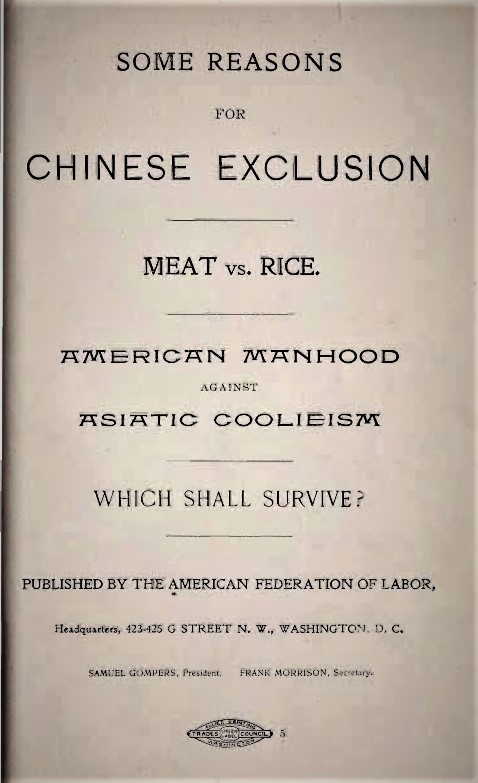
As this clipping from the Sacramento Daily Union of October 17, indicates, the many lodgings for the Chinese laborers on Oneida Place were generally unsound.

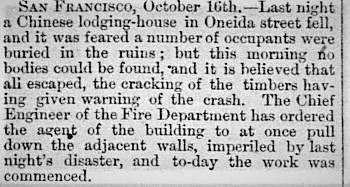
In spite of its lower profile when compared to Chinatown’s other alleyways and small streets, Oneida would occasionally serve as a location for newsworthy events, as this June 30, 1892, report in the Sacramento Daily Union about an opium processing house attests:
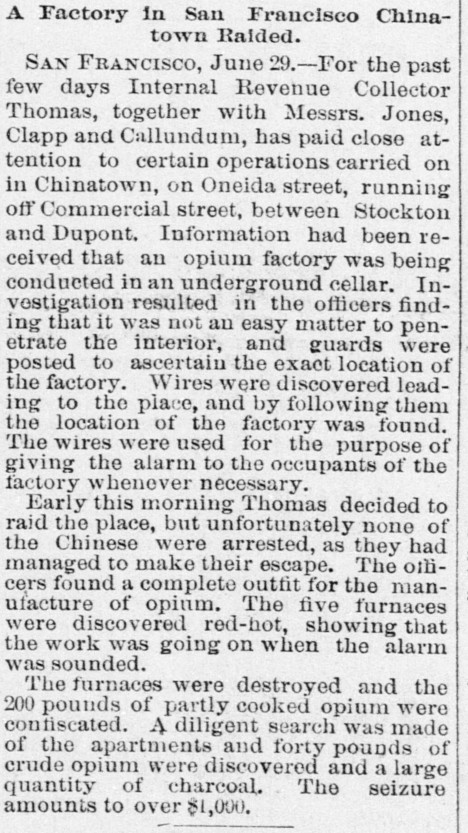
Research about this small, but important, corner of Chinatown continues.
#Lord Tam temple#Oneida Place#Charles Albert Rogers#Tam Gung#Tam Tai Sin#Frederic Masters#Samuel Gompers#Meat vs. Rice
2 notes
·
View notes
Text
... introducing ogden college’s resident nightmare dream boy !
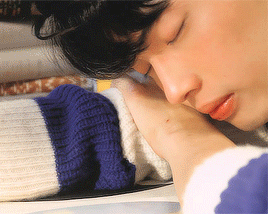
{ WIN METAWIN, 21, CIS MAN, HE/HIM } Is that PORNTHEP “RAIN” PHASUK ? A SENIOR originally from NEW LONDON, NH, they decided to come to Ogden College to study GOVERNMENT. They’re THE SOCIAL CLIMBER on campus, but even they could get blamed for Greer’s disappearance.
BASICS
full name: pornthep phasuk (thai: พรเทพ ผาสุข)
nickname: rain (nicknames are important in thai culture so pls use this when referring to him!)
birth date: november 28, 2000
gender: man (cis)
sexuality: straight 😔😔😔
known languages: english (native), thai (fluent), chaoshan min (fluent, particularly the teochew dialect)
ethnicity: han chinese and thai
height: tall. he’s 6′3″
label: the social climber
some tropes that apply to him (from tv tropes):
social climber (you know this one)
mock millionaire (a fake rich person)
handsome lech (a conventionally attractive guy whose personality eventually drives away the girls he attracts)
the social expert (someone well-versed in social manipulation)
stepford smiler (fake smiler)
smarter than you look (self-explanatory!)
the hedonist (devoted to pleasure)
BIOGRAPHY
primadonna girl... all he ever wanted was the world... he can’t help that he needs it all!!!!
lmfao but basically yeah, he’s a lot of marina and the diamonds song rolled into one person (especially ones like “are you satisfied?” - if you want to get a sense of who he is quick, go listen to that song or read the lyrics)
his parents are a rich politician in thailand and his much younger mistress. (the dad was in his 40s, the mom was still 20 when he was conceived. it was fucked up.) his dad paid his mom off to leave the country so they could avoid controversy. hence, he and his mom moved to the usa.
although his mom was given a good amount of money, being a young woman knocked up by a sleazy powerful dude and having to be all alone in a new country messed up her mind. she didn’t know how to be a good mom. plus the payment wouldn’t last forever.
rain’s mom was pretty toxic and negligent. rain never had anyone to teach him how to love... making it something of miracle that he’s very much capable of loving, even if he himself tries to seem heartless.
knowing that his dad is rich but he never really got access to that wealth, he became obsessed with appearing to be rich. as a teenager, rain began to steal stuff and scam people so he could make himself look wealthy.
he has stolen, he has scammed, he has shoplifted.
when he was around 18, he also began to pose as older women’s young trophy boyfriend. it was not a pleasant experience and those women were often abusive and possessive, but he really wanted to earn more money and nice stuff (like jewelry and clothes).
so now he’s got a lot of followers on social media. he’s also a soccer player and a streamer (he plays video games on his streams).
his ambition is to become the usa’s youngest congressman ever. (the recorded youngest jed johnson was 24 upon election; rain plans to be a congressman before 24.)
he also wants to be a movie star after being a congressman or like, if the whole politics thing doesn’t work out.
although he’s vain, materialistic, a fuckboy, self-obsessed, you name it... he actually does have legit plans for social reform in the usa. he sees how people suffer (especially because he himself is southeast asian and the son of an economically disadvantaged woman + immigrant). he cares.
he tries to seem like he doesn’t have a heart, but he does.
he was greer’s friend, though he never cared for her beyond wanting to get ahead in life. she was a good friend to have if you wanted to socially advance.
wanted connections: enemies (he sure has them), frenemies, friends, besties, cousins (he can be related to ethnically chinese and/or thai people), fwb, ex-girlfriends, you know the drill!
4 notes
·
View notes
Photo
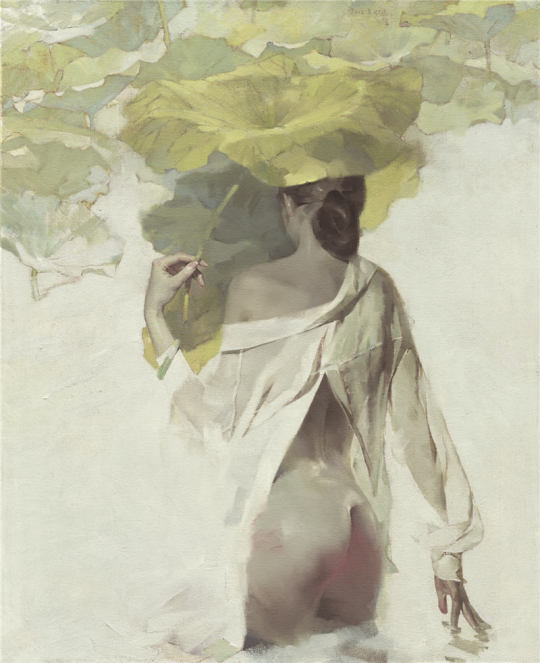

Lin CHUNXIAO 林純孝 Chinese
born in 1943, He is a member of Guangdong Artists Association, Shantou painting Academy painter. His paintings with a unique artistic style, which is full of modern atmosphere and Chaoshan amorous feelings, exquisite Characterization, light delicate and pretty color, with high artistic quality , conspicuous and popular.
youtube
6 notes
·
View notes
Text
Yingge performers dancing Chaoshan yingge (潮汕英歌舞). Yingge is southern Chinese popular folk dance.
Song: Nijamena - Anurag Kulkarni
#潮汕英歌舞#英歌#yingge#chinese dance#douyin#video#tiktok#folk art#this song is really popular to use for yingge videos idk why it just is#the actual sound that you would hear becides stomps is the clack of wooden sticks and gongs#funniest typo award goes to me#becides....
369 notes
·
View notes
Text
Heroic! Women's Yingge Team's "Chinese War Dance"
youtube
On February 24th, our reporters encountered a women's Yingge dance team at the Shantou International Lantern Festival. Yingge, known as the Chinese war dance, dates back to the Ming Dynasty and has been preserved to the present day. The "Chinese War Dance" is one of the most powerful traditional performances in the Chaoshan New Year, symbolizing prayers for a good harvest and favorable weather in the coming year.
According to interviews, the girls in the group, aged 14 to 16, have been practicing for over a year and a half for this performance. They are deeply passionate about Yingge dance and dedicate two and a half hours after school to practice it every day with their peers.
"Since I was a child, I have watched Yingge dance performances. They are so elegant and valiant. I like it very much!" a member of the team told reporters.
0 notes
Text
Blog 5 sources and significance
An investigation of color aesthetics and character design in the film“ I Am What I Am (2021)”
This Chinese animated film tell the three young Guangdong people about lion dance dream. The animated movie " I am what I am(2019)" tells the story of a poor young man named Juan and his friends from southern rural areas in the early 21st century , through participating in a lion dance competition, eventually break through themselves and grow from a lazy "sick cat" to a "lion". The film extracts "Guangdong lion dance" from traditional Chinese folk art as the main element that runs through the entire animated movie (Zhu, 2023) It is worth noting the regional elements in this animated film, such as the director's concentrated display of traditional Lingnan culture in Guangdong, China, and the design of the protagonist Juan also conforms to the characteristics of Cantonese people.
youtube
FULL Movie " I Am What I Am " English Sub Titles | #liondancekid #Action ,Youtube(2024)#liondancehttps://youtu.be/Z57Srwj74Qk?si=l8ATHR8L1DaXyt5W. (Accessed: 10 February 2024)

screenshoot from film I am what I am(2019)
1. The design of the protagonist Juan
The background of this animated movie is around 2000 in Guangzhou, so when designing clothing for Juan, the director chose the popular Cantonese style on that period, such as slippers, ripped pants, tank tops, etc. Interestingly, the director designed a cute curly hair for Juan, which can reflect her simple and innocent personality. Secondly, the director's design of the storyline related to Juan is also very meaningful. The traditional narrative style of Chinese animated films mainly reflects the spirit of hard work being rewarded and realizing dreams, while the director breaks away from the traditional narrative style of Chinese animated films. The protagonist Juan in the film lives in a rural area of Guangdong, where her family is very poor. However, she enjoys the traditional culture of lion dance. When she was about to succeed in the lion dance competition, she gave up her dreams and competition due to family reasons and had to work in the city to make ends meet. But many years later, he resumed lion dancing for some reason and prepared to participate in lion dance competitions again. The director used many montage techniques to reflect the setbacks encountered by Juan, making the audience resonate. In addition, the director pays more attention to the lives of ordinary people because for many poor people, even if they work hard, they will not succeed. Therefore, the realistic storyline designed by the director can better reflect the lives of poor people in China

screenshoot from film I am what I am(2019)
2. The charm of Guangdong Lingnan culture
There are many cultural elements of Guangdong Lingnan in this movie. In the architectural design of Lingnan rural areas, the images of Shunde Baizhang Village, Beishui Village, and Chancheng Chopsticks Road are used as the main reference, delicately depicting cultural landscapes such as ancient village temples, alleys, vegetable markets, and arcade old streets with Lingnan characteristics (Yan and Chen, 2023). The main scene in the movie is the ancestral hall, because the ancestral hall is the belief center of the Chaoshan people in Guangdong. In the Guangdong region, any large family will have their corresponding ancestral hall to commemorate their ancestors. The lion dance originated from the sacrificial performance in the Chaoshan region of Guangdong, China, and is usually performed in the family's ancestral hall on specific festivals. So the ancestral hall in the movie is an important scene, and the conceptual design of the ancestral hall also uses a lot of religious elements from the Chaoshan region. The most obvious feature is the decoration of the ancestral hall in the movie, such as many small sculptures of dragons and phoenixes on the roof, which are also unique ceramic sculptures from the Chaoshan region. In addition, in animated movies, sacrificial elements from the Chaoshan region can be seen in the temple scenes. For example, the stone lion statue in the temple represents the guardian god, while the ancestral tablet and incense burner are enshrined in the temple. The application of these elements in animated movies can bring people's understanding of Guangdong Chaoshan culture
In short, the director of this film breaks the traditional narrative style of Chinese animated films and returns to a realistic style, paying more attention to the lives of the poor in China today. In addition, the director also adheres to cultural confidence, and this film also showcases a lot of Guangdong Lingnan culture, providing audiences with a good visual experience
Reference:
Zhu,L. (2023). The use of traditional culture in Chinese animated films —— Take I Am What I Am as an example. Literary and Art Weekly (22), 56-58.Available at:https://www.cnki.net (Accessed: 10 February 2024)
Yan ,Y & Chen, Q. (2023). Study on the scene construction and the presentation of regional cultural elements in the realistic animation I Am What I Am. New Chu Culture (32),43-46.doi:10.20133/j.cnki.CN42-1932/G1.2023.32.013. (Accessed: 10 February 2024)
FULL Movie " I Am What I Am " English Sub Titles | #liondancekid #Action ,Youtube(2024)#liondancehttps://youtu.be/Z57Srwj74Qk?si=l8ATHR8L1DaXyt5W. (Accessed: 10 February 2024)
0 notes